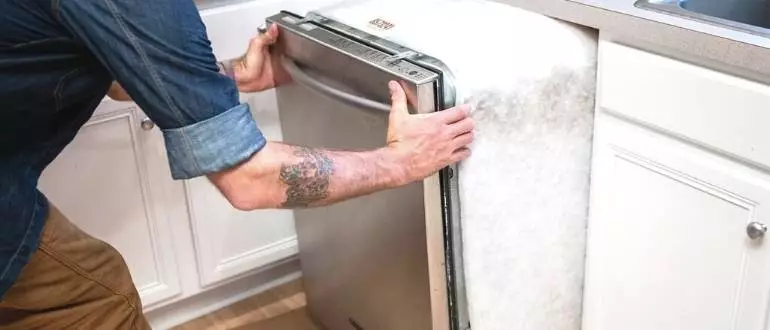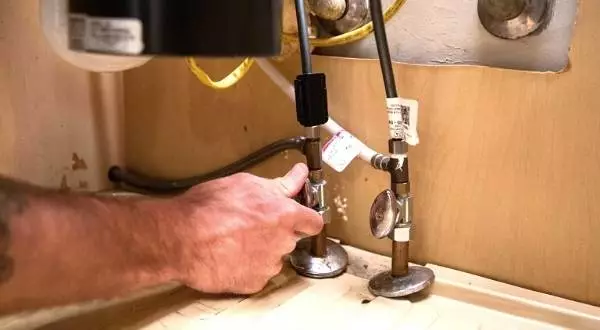How To Pull Out A Dishwasher To Clean Behind It? Easy Steps
A clean kitchen is crucial for your family’s health and the longevity of your appliances.
Often overlooked, the area behind the dishwasher can accumulate debris and grime, creating a breeding ground for bacteria.
Don’t let the task of pulling out your dishwasher intimidate you. Follow these easy steps for safe and efficient cleaning.
Our blog post provides a step-by-step guide on how to pull out a dishwasher to clean behind it.
How to pull out a dishwasher to clean behind it?

Here is a step-by-step guide on how to pull out a dishwasher to clean behind it:
- Turn off the power and water supply
- Remove the bottom kickplate
- Detach the dishwasher from the countertop
- Disconnect the water and drain line
- Carefully pull out the dishwasher
- Clean behind the dishwasher
- Reconnect the water and drain line
- Slide the dishwasher back into place
- Reattach the dishwasher to the countertop
- Turn on the power and water supply
Tools Needed to Pull Out Your Dishwasher
Screwdriver: A flathead or Phillips screwdriver will be required to remove any screws holding the dishwasher in place.
Pliers: Pliers may be needed to loosen any clamps or connectors that are securing the dishwasher to the water supply or drainage system.
Adjustable Wrench: An adjustable wrench will be useful for removing any nuts or bolts that are holding the dishwasher in place.
Towels or Rags: You will need towels or rags to soak up any water that may spill out when disconnecting the water supply and drainage hoses.
Dishwasher Dolly or Furniture Dolly: A dishwasher dolly or furniture dolly will be necessary to move the dishwasher out from its current location without damaging the flooring or the dishwasher itself.
Helper: Having a helper will make the job much easier, as they can help guide the dishwasher out from its current location and assist with disconnecting any hoses or wires.
Step 1: Turn off the power and water supply
Before you start working on your dishwasher, turn off the power and water supply. Locate the circuit breaker that powers your dishwasher and switch it off.

This will prevent any electrical accidents while you work on the appliance.
Additionally, you’ll need to turn off the water supply by closing the shut-off valve located under the sink.
Step 2: Remove the bottom kickplate
Locate the kickplate at the bottom of the dishwasher. Using a screwdriver, remove the screws that secure it in place.
Once the screws are removed, gently pull the kickplate towards you until it pops out. Set the kickplate aside in a safe place.
Step 3: Detach the dishwasher from the countertop
Locate the screws that secure the dishwasher to the countertop. There are usually two screws at the top of the dishwasher.
Use a screwdriver to loosen and remove them. Once the screws are removed, lift the front of the dishwasher slightly to release it from the countertop.
Step 4: Disconnect the water and drain line
Locate the water supply and drain lines that are connected to the dishwasher.
Use pliers to disconnect the water supply line, and carefully detach the drain line by unscrewing it.
If you have trouble disconnecting the lines, use a wrench to loosen the connections.
Be sure to place a bucket or towel underneath the connections to catch any water that may spill out.
Step 5: Carefully pull out the dishwasher

Slowly pull the dishwasher out from its position. If you encounter any resistance, double-check to make sure you have disconnected all the necessary lines.
Be careful not to damage the floor or any nearby objects as you pull the dishwasher out.
Step 6: Clean behind the dishwasher
Now that the dishwasher is pulled out, you can start cleaning the area behind it.
Use a vacuum cleaner or a damp cloth to remove any debris or grime that has accumulated.
Be sure to clean the sides and the back of the dishwasher thoroughly. If there is any mold or mildew, use a solution of water and vinegar to clean it.
Step 7: Reconnect the water and drain line
Reconnect the water supply line and the drain line by screwing them back into place.
Use pliers to tighten the connections, but be careful not to overtighten them.
Make sure there are no leaks by running the dishwasher for a short cycle.
Step 8: Slide the dishwasher back into place
Gently slide the dishwasher back into its original position. Make sure it is level and flush with the countertop. If the dishwasher is not level, adjust the feet until it is.
Step 9: Reattach the dishwasher to the countertop
Screw the dishwasher back into place by reinserting the screws that you removed in step 3.
Make sure the dishwasher is securely attached to the countertop.
Step 10: Turn on the power and water supply
Finally, turn on the power and water supply to your dishwasher. Test it to make sure it is working properly.
Check for any leaks or unusual noises. If everything is working as it should, congratulations, you have successfully pulled out your dishwasher and cleaned behind it!
How Often You Should Clean Behind Your Dishwasher
Here are some guidelines on how often you should clean behind your dishwasher:
Frequency:
You should clean behind your dishwasher at least once a year, although twice a year is recommended if you use your dishwasher frequently.
The best time to clean behind your dishwasher is when you deep clean your kitchen.
During Spring Cleaning:
It’s a good idea to include cleaning behind your dishwasher as part of your annual spring cleaning routine.
This can help you get rid of any stubborn stains or dirt buildup that may have accumulated over the past year.
After Spills:
If there is any spillage of food or liquids behind your dishwasher, it is important to clean it up immediately.
This will prevent any potential moisture buildup that can lead to mold or mildew growth.
When Moving:
If you are moving your dishwasher, it is essential to clean behind it before reinstalling it in a new location.
This will ensure that you are not transferring any dirt, debris, or potential pests to the new location.
Why Cleaning Behind the Dishwasher Is Important
Prevents Pests Infestations
Over time, food particles, grease, and moisture can accumulate behind your dishwasher, creating a breeding ground for pests such as ants, cockroaches, and rodents.
These unwelcome visitors can contaminate your food and spread diseases, making it essential to clean behind your dishwasher regularly.
Reduces Fire Hazards
Dust and debris can accumulate on the heating element or motor of your dishwasher, increasing the risk of fire hazards.
Regularly cleaning behind the dishwasher can prevent the buildup of dust and debris, making your home a safer place.
Improves Dishwasher Performance
If there’s debris or dirt behind your dishwasher, it can affect the appliance’s performance, causing it to work harder to clean your dishes.
This can lead to higher energy bills and ultimately shorten the lifespan of your dishwasher.
Cleaning behind your dishwasher can prevent this issue and help your appliance to function more efficiently.
Prevents Water Damage
If there’s a leak in your dishwasher’s water supply line, it can cause water damage to the wall or flooring behind the appliance.
Regularly cleaning behind the dishwasher can help you to spot any potential leaks early, preventing water damage and costly repairs.
Maintains a Clean and Hygienic Kitchen
Cleaning behind your dishwasher can help to prevent the growth of bacteria and mold.
Food particles that get trapped behind the dishwasher can lead to unpleasant odors and create an unhygienic environment.
Regular cleaning behind the dishwasher can help to prevent these issues and keep your kitchen clean and fresh.
FAQs about Pulling Out A Dishwasher To Clean Behind It
How to move a dishwasher efficiently?
Remove all the connections from the dishwasher, including the power source, water supply line, and drain line.
Then detach all the attachments carefully and remove them from the counter.
Then adjust the dishwasher’s feet and cardboard under it. Finally, rock and pull the dishwasher to move to the desired place.
How to lower the dishwasher leg after pulling out?
Strongly push the dishwasher against its top to take some weight off the legs.
It will help adjust the legs easily. To lower the leg of the dishwasher, twist counterclockwise.
If it is difficult for the hand, use an adjustable wrench or hex head socket.
Is a dishwasher too heavy to pull out?
The weight of the dishwasher is around 150 to 175 pounds. So a dishwasher can be too heavy for some people.
You should get the aid of your friend and maintain essential precautions to pull it out safely and properly.
Final words
The dishwasher is quite a large kitchen appliance, and pulling it out can be difficult. Although an installed dishwasher remains attached with plenty of connection and attachment.
It makes the process challenging by increasing the risk. Therefore, people feel lazy about pulling it out and cleaning behind it.
But throughout the guide, we have explained a step-by-step formula on how to pull out a dishwasher to clean it.
Hopefully, following this technique will allow you to clean behind the dishwasher safely and successfully.
